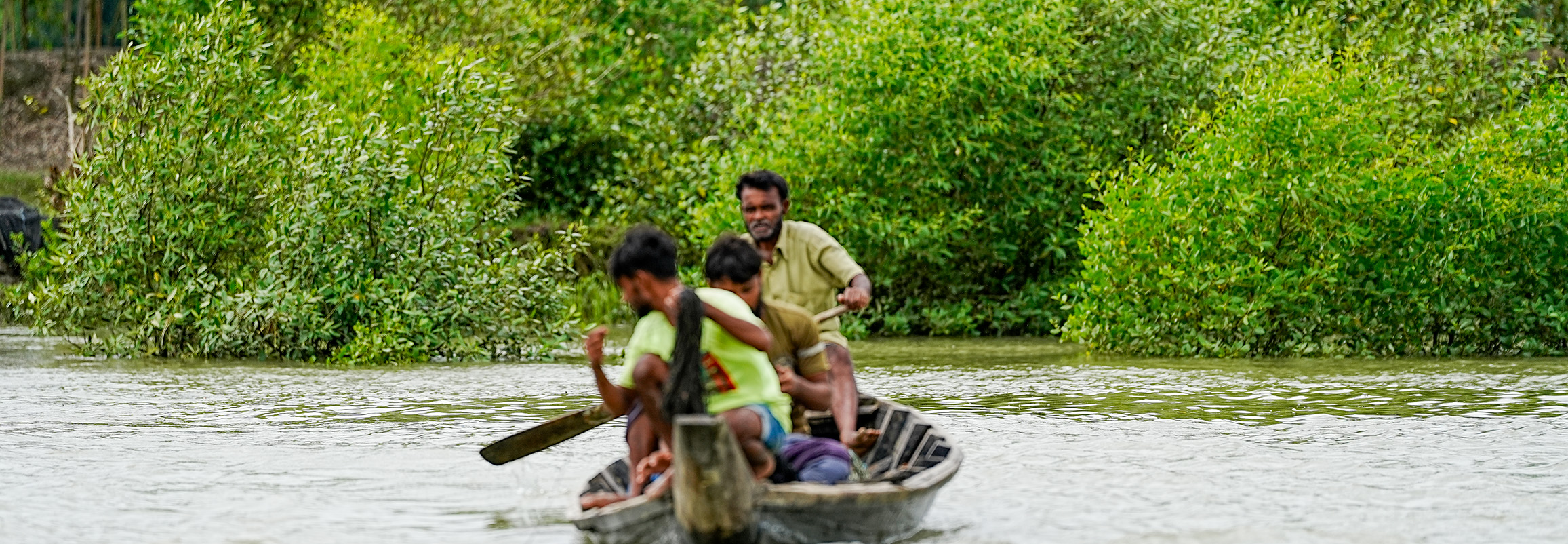Once a thriving mangrove forest at the mouth of the Matamuhuri River, the Chakaria Sundarbans was erased by decades of shrimp farming and salt production. Now, the landscape is stirring back to life. Under the Sustainable Coastal and Marine Fisheries Program (SCMFP), Arannayk Foundation is replanting over 235,000 mangrove and non-mangrove trees along 70 kilometers of coastal embankments—reviving soil, wildlife, and livelihoods. For residents like Erfan, Mohiuddin, and Hasan, the green return means more than protection from cyclones; it’s the return of shade, birdsong, and hope.
 © AF/Arifur Rahman
© AF/Arifur RahmanThe tide in Chakaria moves like breath - slow, certain, and constant. When it retreats, the exposed embankments shimmer with patches of new green. Young Keora and Gewa seedlings bend in the wind, their roots gripping the clay that once lay bare.
A generation ago, this land was dense with mangroves. The Chakaria Sundarbans was a forest of 18,000 hectares, sheltering birds, crabs, and fishermen alike. Then, in the rush for shrimp, the forest fell. Ponds replaced trees, and the tide carried away the soil that once held the coast together.
“Back then, the wind had nothing to stop it,” says Erfan Uddin, now in his forties. “I was ten during the 1991 cyclone. The embankment broke, and our shrimp farms washed away. If mangroves come back, they’ll not only block the storms - they’ll bring fish back to the river.”
His memory lingers in the salty air - a reminder of what the forest once promised, and what its loss cost.
The Return of Green
Today, that promise is being renewed under the Embankment plantation project through Sustainable Coastal and Marine Fisheries Program (SCMFP), led by the Department of Fisheries and supported by the World Bank.
Arannayk Foundation, the implementing partner, is restoring 70 kilometers of coastal embankments with a mix of mangrove and non-mangrove tree species that can both resist salt and serve people.
 © AF/ Mohammed Hossain
© AF/ Mohammed HossainVoices from the Embankment
On a midday break, Md. Hasan leans on a spade and smiles.
“There isn’t a single tree near here,” he says. “At lunch, we walk far just to find one for shade. If this plantation survives, these trees will give us shelter again and some peace in this heat.”
Not far away, Mohiuddin, a 27-year-old youth, watches a row of saplings swaying under the wind. “There are no birds because the land is still barren,” he says quietly. “But if these seedlings grow, the embankment will become a living shield. Maybe the birds will come back, too.”
Nature Begins to Answer
Within months, the results start to show. The soil holds moisture longer. Crabs burrow near the roots. Small fish return to the flooded channels. For the first time in decades, parts of Chokoria sound alive again.
A blend of mangrove and non-mangrove seedlings now stands between the river and the settlements - a human-made greenbelt where the forest once was. These young trees are more than protection; they are proof that restoration can be real when people believe in it.
Hope in the Wind
In the evening light, fishermen prepare to journey home, their laughter carried by the tide. The saplings sway in rhythm with the waves - soft, persistent, growing.
“This land once looked dead,” says Erfan, watching the sun dip behind the trees. “Now it feels like it’s forgiving us.”
The Chakaria Sundarbans may never return to its full past glory, but it is no longer silent. Each planted root anchors more than soil - it anchors memory, resilience, and the promise that the coast can live again.
Comments
I would like to contact you for the multiplication of Mangrove.
Is the multiplication a problem ?
Now growing from seeds ?
Hope to hear from you.
Willem